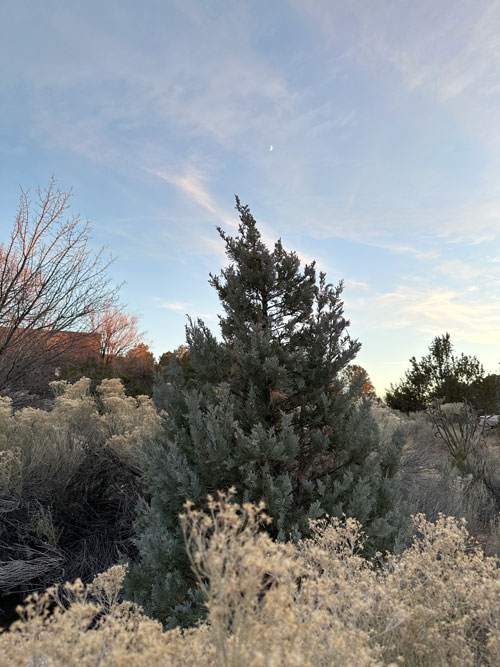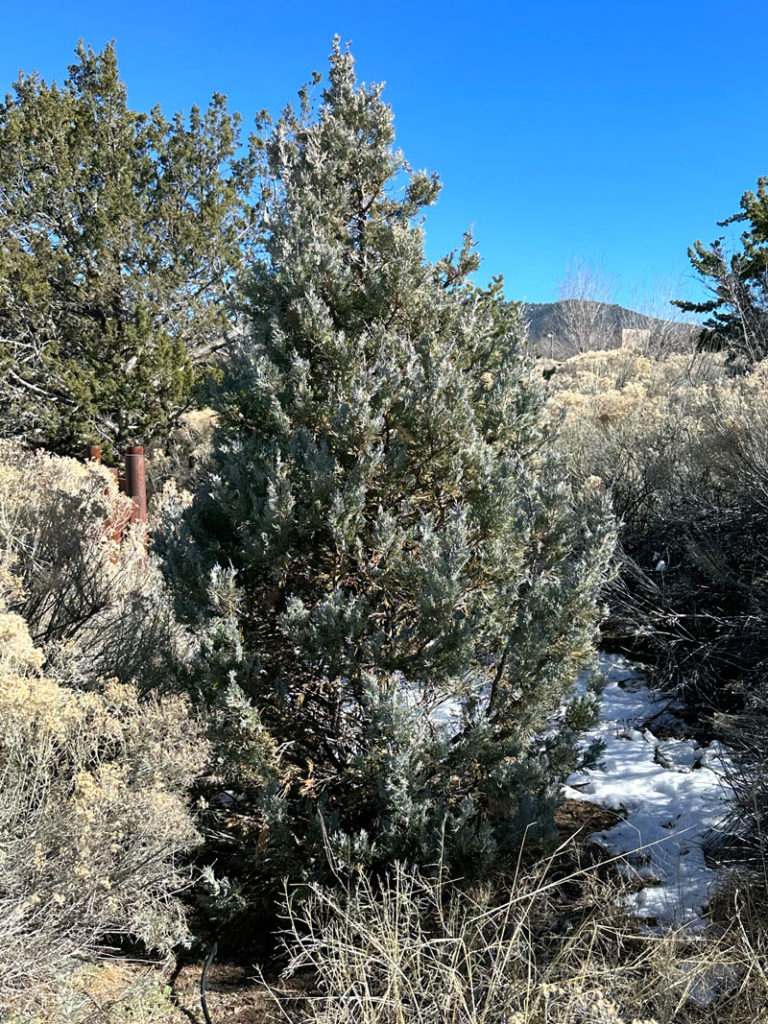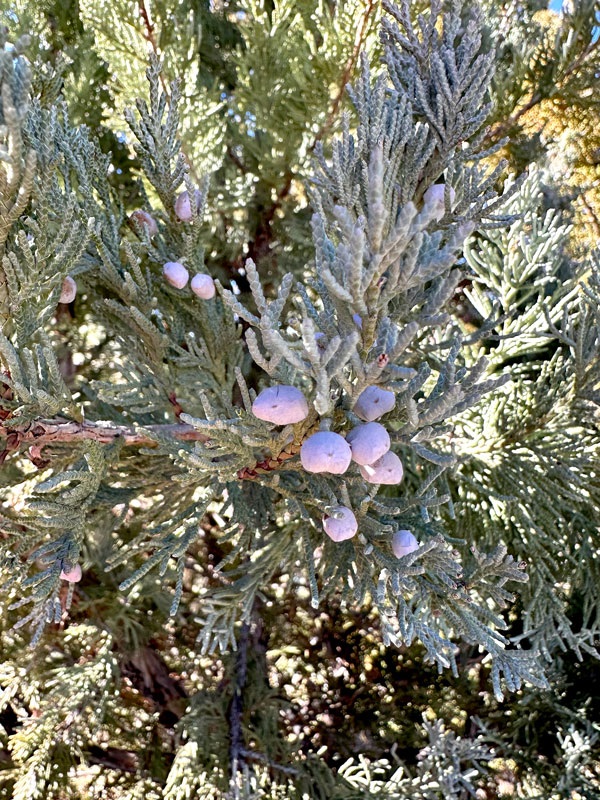Scientific name: Juniperus scopulorum ‘Moonglow’
Common name: Rocky Mountain juniper, cultivar ‘Moonglow’ 
Family: Cupressaceae
By Claudia Karll
I am writing to you today in early November from my apartment in Seattle, WA. Needless to say, the contrast with Santa Fe is huge. Dodging the puddles from the rain last night, I took a walk with my husband this morning and saw red maple leaves carpeting the sidewalks, smelled the cotton candy scent of the yellow leaves still clinging to the katsura trees (Cercidiphyllum japonicum), and marveled at all the colors still to be seen: purple-red and pink-green hydrangeas, orange cutleaf Japanese maples, pink or peach-colored roses, white snowberry, green sword ferns, and so much more. December will still have occasional flowers in Seattle but not so in Santa Fe. For this reason I would like to direct your attention to a conifer prized for its foliage that will sparkle in the moonlight of Santa Fe’s cold wintry nights.
Background on the name: This cultivar of Rocky Mountain juniper has showy, silvery blue foliage that reflects strong moonlight, thus the name ‘Moonglow’. Scopulorum (genitive plural of scopulus) means “of the mountains” and is used to describe plants associated with rocky places.

Range of native growth: The native species, Juniperus scopulorum, has a natural range in western North America along the Rocky Mountains from southwest Canada to the Great Plains of the United States. In terms of conservation status, it is labeled “least concern”.
 Description of the main morphology: The evergreen, female cultivar ‘Moonglow’ is characterized by moderate growth, reaching 20 feet in height and 8 feet in circumference. In contrast, the native species, Juniperus scopulorum, grows to between 16 and 49 feet tall. Its shape is pyramidal. The tree is dioecious, meaning each individual tree is either male or female and produces pollen cones in early spring of its own sex.
Description of the main morphology: The evergreen, female cultivar ‘Moonglow’ is characterized by moderate growth, reaching 20 feet in height and 8 feet in circumference. In contrast, the native species, Juniperus scopulorum, grows to between 16 and 49 feet tall. Its shape is pyramidal. The tree is dioecious, meaning each individual tree is either male or female and produces pollen cones in early spring of its own sex.
Ecology: Monrovia classifies ‘Moonglow’ as benefitting birds. Wikipedia states that the Bohemian waxwing eats the berries of the native species Juniperus scopulorum. Specifically, one bird was observed to eat 900 berries in five hours. ‘Moonglow’ generally resists grazing by deer due to its tight growth of branches.
Natural history: Regarding the native species Juniperus scopulorum (but not the cultivar specifically), different parts of the plant (leaves, inner bark, cones, berries) have been prepared and used by Native Americans to ease or cure various maladies. And like smudges of sage, the smoke from burning cedar bundles is used for cleansing of evil spirits and subsequent healing.
Gardening tips: The cultivar ‘Moonglow’ is recommended for USDA Zones 3-7.
‘Moonglow’ needs full sun. Its water needs are low once established, but it should be watered when the top two inches of soil are dry. It is well suited to use as a privacy screen, a windbreak, or even a topiary (in a pot). It pairs well with Barberry (Berberis), Rose (Rosa), Catmint (Nepeta), Russian Sage (Perovskia), and large grasses.
‘Moonglow’ juniper is generally healthy with adequate moisture, and has relatively few pests. The Santa Fe Botanical Garden planted 19 beautiful ‘Moonglow’ junipers in our Orchard Gardens in 2013, but many of them arrived with, or became subsequently infested with Western Cedar Borer (Trachykele blondeli Marseul). There are no practical controls or preventive measures for this flatheaded wood boring insect, one of the serious pests of junipers, and many of the trees died within 2 years of planting.
There are still several specimens of ‘Moonglow’ at the Santa Fe Botanical Garden and elsewhere in town. With the full moon this month on December 7, fingers crossed that you can see one in its silvery splendor!
Sources
“Juniperus scopulorum”. Garden Explorer. Santa Fe Botanical Garden. 31 Oct. 2022. Web. 3 Nov. 2022. Retrieved from https://santafebotanicalgarden.gardenexplorer.org/taxon-453.aspx
“Juniperus scopulorum”. Wikipedia.org. 23 Sept. 2022. Web. 2 Nov. 2022. Retrieved from https://en.wikipedia.org/wiki/Juniperus_scopulorum
“Moonglow Juniper.” Monrovia.com. 2022. Web. 2 Nov. 2022. Retrieved from https://www.monrovia.com/moonglow-juniper.html
Nix, Steve. “How to tell the difference between Cedars and Junipers”. Treehugger.com.
23 May 2022. Web. 3 Nov. 2022. Retrieved from https://www.treehugger.com/difference-between-cedars-and-junipers-4165305
“Scopulorum.” Wiktionary.org. 17 July 2022. Web. 2 Nov. 2022. Retrieved from https://en.wiktionary.org/wiki/scopulorum


